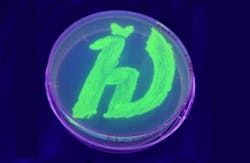Tiny engineered fluorescent protein withstands high temperatures
A team of biophysicists from the Moscow Institute of Physics and Technology (MIPT; Moscow, Russia) and colleagues from France and Germany has created a new fluorescent protein that not only glows when irradiated with ultraviolet and blue light, it is exceedingly small and stable under high temperatures. The research team believes the protein holds promise for fluorescence microscopy, a technique being used in research on cancer, infectious diseases, and organ development.
Fluorescence microscopy is a method for studying living tissue that relies on induced luminescence. After being exposed to laser radiation at a particular wavelength, some proteins emit light at a different wavelength. This induced glow can be analyzed using a special microscope. Researchers append such fluorescent proteins to other proteins via genetic engineering to make the latter ones visible to the microscope and observe their behavior in cells.
Up until now, the fluorescent proteins used for such observations had several flaws. They were vulnerable to heat, fairly bulky, and only glowed in the presence of oxygen.
"For one thing, our protein is more thermostable than its analogues: It only denaturates at 68 degrees Celsius," says Vera Nazarenko from the MIPT Laboratory of Structural Analysis and Engineering of Membrane Systems, the lead author of the paper that describes the work. "It is also miniature, while most of the currently used fluorescent proteins are rather bulky. On top of that, it can emit light in the absence of oxygen."The research team originally identified the protein with these remarkable properties in the cells of a thermophilic bacterium (that is, one that lives in high-temperature environments such as hot springs). The researchers then genetically engineered a DNA sequence that reproduced the protein's fluorescent segment but not the other parts, which would make the molecule larger.
By introducing the gene that encodes the protein into the cells of another bacterium, E. coli, the team turned it into a factory mass-producing the fluorescent protein with unique properties. In doing so, they can now obtain essential data on cell life and death.
Full details of the work appear in the journal Photochemical & Photobiological Sciences.

